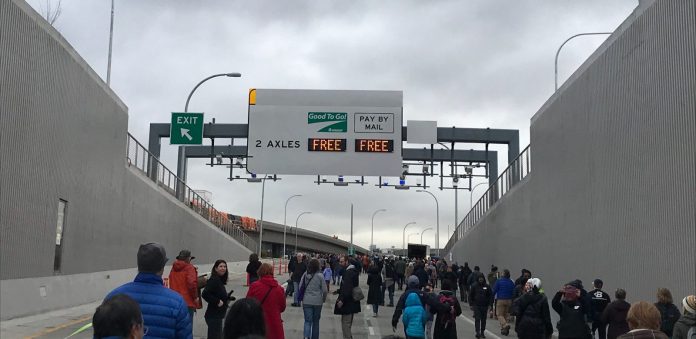On Tuesday, the Move All Seattle Sustainably (MASS) coalition released a post-mortem report on the three-week viaduct closure and proclaimed the success of non-car commutes.
“The closure of the Alaskan Way Viaduct was hyped as a potential traffic disaster that Seattle would have to endure for three weeks,” MASS stated in its press release. “Instead we saw more people on transit and bikes, and a blessedly quiet downtown. The twenty buses Metro added turned out to be much nicer than the 90,000 cars that formerly streamed across our waterfront and up Aurora Ave.”
The three-week exercise doesn’t mean the fight to lower car dependency is over. In fact, traffic actually seemed to be worse this week with the tunnel open, foreshadowing plenty of work ahead.
“‘Viadoom’ is over but the Seattle Squeeze is not. We hope the experience of these three weeks will embolden Mayor Durkan and SDOT to move forward with dramatic improvements to transit, biking, walking and rolling infrastructure, as recommended by the MASS Coalition,” said Katie Wilson, General Secretary of the Transit Riders Union, a MASS coalition member. “‘Build it and they will come’–all the evidence points in this direction.”
SDOT Tries to Explain Lack of Viadoom
That same day, Heather Marx, who is the director of downtown mobility for the Seattle Department of Transportation (SDOT), briefed the transportation committee of the Seattle City Council on data from the closure and what the agency learned from it. She admitted she underestimated the potential of bikes to move people, referring to when she called getting more people to bike in January “a heavy lift.”
“I’ve never been so happy to be so wrong,” Marx said, pointing to bike counts that jumped big time, even doubling at the West Seattle Bridge.
Marx also said the water taxi saw ridership triple on its West Seattle route after doubling service. She credited teleworking as fueling the shift that made it seem like 90,000 cars disappeared that normally used the viaduct.
Designing a Doom-Proof System
MASS emphasized that the viaduct closure should be a learning experience and help us avoid future mistakes like expanding highway capacity in an urban environment and gumming up bus routes, bike routes and pedestrian crossings.
“Viadoom turned out to be a wildly successful experiment in how to reduce emissions, improve mobility, and better our quality of life,” MASS stated. “Understanding why Viadoom didn’t happen can help us make future transportation policy decisions with equally happy results.”
MASS wants bus lanes, a complete safe biking network, a safe pedestrian network, and signal priority geared toward people walking, rolling, biking, and in transit. So far SDOT has taken an wait-and-see approach, promising it’s ready to add temporary bus lanes or signal changes as necessary.

Bus lanes seem increasingly necessary. Just this morning this reporter had the joy of a riding a jam-packed Route 62 into a Dexter traffic jam exacerbated by the new SR-99 tunnel off-ramp. The Mercer Mess is messier with a new traffic funnel feeding into it, as it should have been easy to predict if traffic engineers didn’t have their heads in the sand.
With the closure behind us, it seems our government’s priorities have swung sharply back to cars. The Washington State Department of Transportation (WSDOT) is back to begging people to drive and apparently closing a bus-only lane serving one of the busiest bus stops in Seattle.
Why did we go back to a car-first mentality? Even asking commuters not to drive in a concerted way (when so often we tip-toe around the issue) seemed to have an effect during the closure.
“Preceding the Seattle Squeeze, our leaders provided some additional transportation infrastructure in the form of added buses, water taxis, and bus lanes, and prevailed on people to do the right thing,” said Alice Lockhart, with 350 Seattle’s transportation team. “The response was great, with bike counters up, water taxi use tripling, and more people on buses. This gives me hope that the Mayor’s office, SDOT, and Metro can bravely lead to build and also promote the transit, bike lanes, and pedestrian/rolling infrastructure that will let us all get to work without high-carbon commutes.”
Snow Spoils Tunnel Launch
Meanwhile in car land, a winter storm wreaked havoc on Seattle streets and spoiled WSDOT’s rollout of its $4 billion new tunnel, with traffic volumes down sharply from the 90,000 cars per day that used to use the Alaskan Way Viaduct. By the way, WSDOT predicts SR-99 traffic volumes will actually increase about 35% before tunnel tolling starts this summer.
With driving conditions improving on Wednesday, KIRO reported a four-mile backup “nearly to the West Bridge” formed in the tunnel as the exits on the South Lake Union side of the tunnel couldn’t empty fast enough. Turns out the Mercer Mess isn’t the best place to put more cars.
To further dampen the grand opening, the exhaust fans in the tunnel don’t seem to be operating properly yet, and the tunnel filled with “smoke and haze,” according to KIRO. WSDOT manually triggered the giant yellow exhaust fans, but motorists were not happy to be breathing their own fumes. Cars, after all, are externalizing machines and bearing the full social costs of driving them isn’t part of the equation–even if it should be.
Doug Trumm is publisher of The Urbanist. An Urbanist writer since 2015, he dreams of pedestrian streets, bus lanes, and a mass-timber building spree to end our housing crisis. He graduated from the Evans School of Public Policy and Governance at the University of Washington in 2019. He lives in Seattle's Fremont neighborhood and loves to explore the city by foot and by bike.


